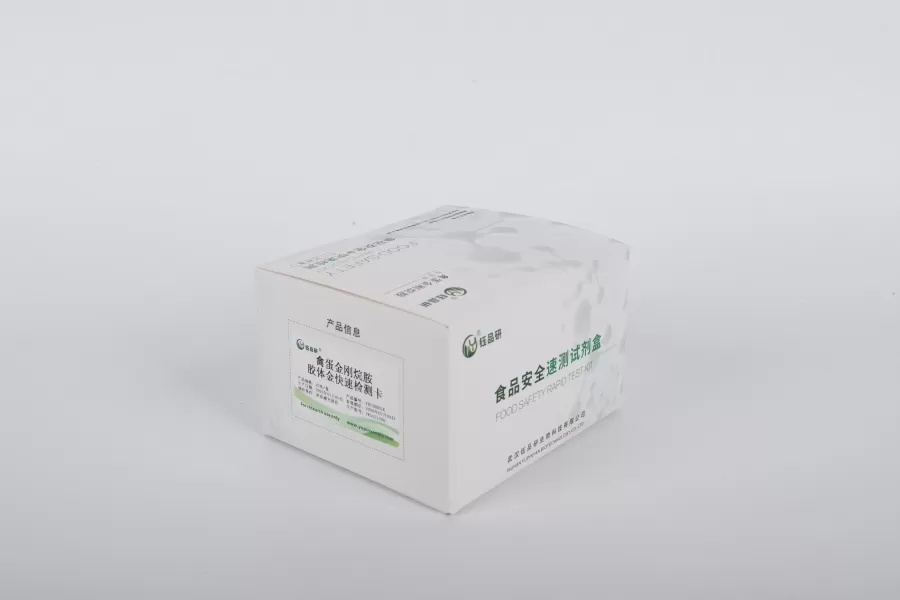As an important source of protein in the daily diet, the quality and safety of poultry eggs are directly related to the health of consumers. In recent years, with the change of the breeding environment and the influence of factors such as feed use, there may be safety hazards such as salmonella, veterinary drug residues, and mycotoxins in poultry eggs. Traditional detection methods often have problems such as time-consuming, complex equipment, and high operating thresholds, making it difficult to meet the needs of rapid screening. With its fast, accurate and convenient characteristics, colloidal gold detection cards have become an important tool in the field of rapid detection of poultry egg quality, providing strong support for the whole chain safety supervision of poultry eggs from production to circulation.
The core principle of the colloidal gold detection card is to use the specific antibodies labeled with colloidal gold to generate an immune reaction with the target substances (such as antigens) in the sample, and to judge the detection results through the color development results. Its basic structure includes sample pad, binding pad, reaction film and absorbent pad. The target in the sample passes through each area in turn under capillary action, reacts with the detection line and quality control line, and finally presents a visible strip. This method does not require large instruments, the operator can master it after simple training, and the detection time is usually within 30 minutes, which greatly improves the detection efficiency.

In practical applications, the detection process of the egg colloidal gold detection card is mainly divided into three steps: sample pretreatment, sample addition detection and result interpretation. In the sample pre-processing process, an appropriate amount of egg samples (such as egg liquid, eggshell surface wiping samples, etc.) should be taken, and impurities should be removed by buffer dilution, centrifugation, etc., to obtain a clarified sample solution. When adding samples, drop the treated samples into the detection card and sample holes to fully infiltrate each reaction area; then let the reaction stand. During the period, the time should be strictly controlled to avoid insufficient reaction or excessive influence on the accuracy of the results.
The result interpretation is the key link. If the detection line (T-line) and the quality control line (C-line) are both clear in color, it is determined to be negative; only the quality control line is color-developing, and the detection line is not color-rendering positive; if the quality control line is not color-developing, whether the detection line is color-developing or not, it is considered invalid and needs to be re-tested. This interpretation method is intuitive and clear, which can quickly provide a basis for decision-making.
Compared with traditional detection methods, colloidal gold detection cards have significant advantages in rapid detection of poultry egg quality: first, the speed is fast, and the detection can be completed within 30 minutes to meet the needs of on-site screening; second, the specificity is strong. Through monoclonal antibody and other technologies, the target substance can be accurately identified and false positive interference can be reduced; third, the operation is simple, no professional equipment and complex operations are required, and grass-roots personnel can use it directly; fourth, the cost of a single detection is low, and the cost of a single detection is much lower than that of large-scale instrumentation, which is suitable for large-scale promotion.
At present, colloidal gold detection cards have been widely used in daily sampling inspections of poultry egg production bases, rapid screening in wholesale markets, raw material checks in catering enterprises, and emergency detection by regulatory authorities. In the process of use, it is necessary to pay attention to the standardized collection and preservation of samples (such as refrigerated transportation at 4 ° C), the test card needs to be used within the valid period, and the operating environment should be kept clean to avoid cross-contamination.
With the increasing supervision of food safety and the continuous advancement of technology, colloidal gold test cards will play a greater role in the field of rapid detection of poultry egg quality. By combining it with an information management system, real-time upload and traceability of test data can be realized, and an early warning system for poultry egg safety risk can be built to protect consumers' "safety on the tip of the tongue".

